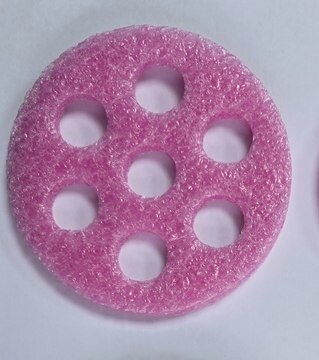Unfortunately, there is no direct correlation between linear pore size measurements and nominal pore ratings based on retention of globular proteins (MWCO). However, several publications are available describing the separation of QDs by size based on the membrane MWCO. Please see the link below to review an example of one such publication:
https://pmc.ncbi.nlm.nih.gov/articles/PMC8271461/
D9652
Membrana de celulose para tubos de diálise
avg. flat width 33 mm (1.3 in.)
Sinônimo(s):
Membrana de celulose, Membrana de diálise, Tubos de diálise de celulose
Selecione um tamanho
R$ 1.624,00
Selecione um tamanho
About This Item
R$ 1.624,00
Produtos recomendados
diâmetro médio
21 mm , when full
largura média plana
33 mm (1.3 in.)
capacidade
~110 mL/ft
Procurando produtos similares? Visita Guia de comparação de produtos
Categorias relacionadas
Descrição geral
Embalagem
Qualidade
Nota de preparo
Código de classe de armazenamento
13 - Non Combustible Solids
Classe de risco de água (WGK)
WGK 3
Ponto de fulgor (°F)
Not applicable
Ponto de fulgor (°C)
Not applicable
Escolha uma das versões mais recentes:
Certificados de análise (COA)
It looks like we've run into a problem, but you can still download Certificates of Analysis from our Documentos section.
Se precisar de ajuda, entre em contato Atendimento ao cliente
Já possui este produto?
Encontre a documentação dos produtos que você adquiriu recentemente na biblioteca de documentos.
Os clientes também visualizaram
Conteúdo relacionado
Dialysis Tubing
-
What is the molecular weight cut off for the Dialysis tubing cellulose membrane avg. flat width 33 mm (1.3 in.) with product number D9652? Is this suitable for purification of Quantum Dots which have size range from 2-10nm.
1 answer-
Helpful?
-
-
Which organic solvents can be used with these membranes?
1 answer-
Regenerated cellulose membranes are typically compatible with acids and alcohols. Organic solvent compatibility varies from compound to compound. However, the solvent concentration, temperature, and exposure time are factors to be considered. Please see the table below to review the general membrane compatibility with various solvents.
Helpful?
-
-
how do I prepare the tubings before usage?
1 answer-
Instructions have been provided in the 'Preparation Note' in the 'DESCRIPTION' section.
-Wash the tubing in running water for 3-4 hours to remove glycerol included as a humectant.
-Treat the tubing with a 0.3% (w/v) solution of sodium sulfide at 80°C for 1 minute to remove sulfur compounds.
-Wash with hot water (60°C) for 2 minutes, followed by acidification with a 0.2% (v/v) solution of sulfuric acid, then rinse with hot water to remove the acid.
This tubing will retain most proteins of molecular weight 12,000 or greater.Helpful?
-
Active Filters
Nossa equipe de cientistas tem experiência em todas as áreas de pesquisa, incluindo Life Sciences, ciência de materiais, síntese química, cromatografia, química analítica e muitas outras.
Entre em contato com a assistência técnica






